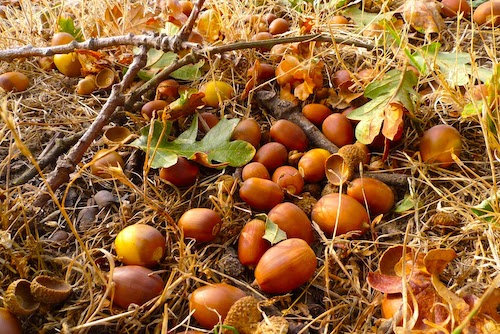3 Types of Simple Samhain Rituals

by Corinna Wood
Curious what it would take to create simple Samhain rituals and Samhain blessings at home? It's easier than you might think. And honoring this seasonal marker is a powerful opportunity for healing.
In this article, I'll share 3 ways to engage the potent energies of this turning of the wheel.
Table of contents
- What is Samhain?
- 3 Types of Samhain rituals
- A Samhain ritual example
What is Samhain?
 Samhain (pronounced SAH-win) is the “holy-day” at the root of today’s North American Halloween holiday on October 31st.
Samhain (pronounced SAH-win) is the “holy-day” at the root of today’s North American Halloween holiday on October 31st.
Also known as All Hallow’s Eve, Samhain marks the halfway point between autumn equinox and winter solstice. I like to honor Samhain for three days, from October 30 through November 1 (also known in Mexico as the Day of the Dead).
Many cultures consider this to be a time of year when the veils between the worlds thin. So this is a powerful time to connect with our beloved dead and ancestors.
As the leaves fall, we're naturally drawn to mourn and to grieve losses in our lives. It can also be a time for letting go of the past year or old aspects of yourself.
As a gardener and herbalist, I honor this turning as the ending of the harvest season. The plants are withdrawing their energy from their aboveground portions and sending it down to the roots.
Where Samhain falls in the context of the Wheel of the Year
As much as I love the green and growing things, my favorite time of year is when the year wanes from Samhain towards winter solstice.
As the leaves fall and the nights lengthen in this season, you're naturally pulled inward.
From the threshold point of Samhain through winter solstice, we can embrace the darkness and the void—until celebrating the new year at Imbolc (the halfway point between winter solstice and spring equinox).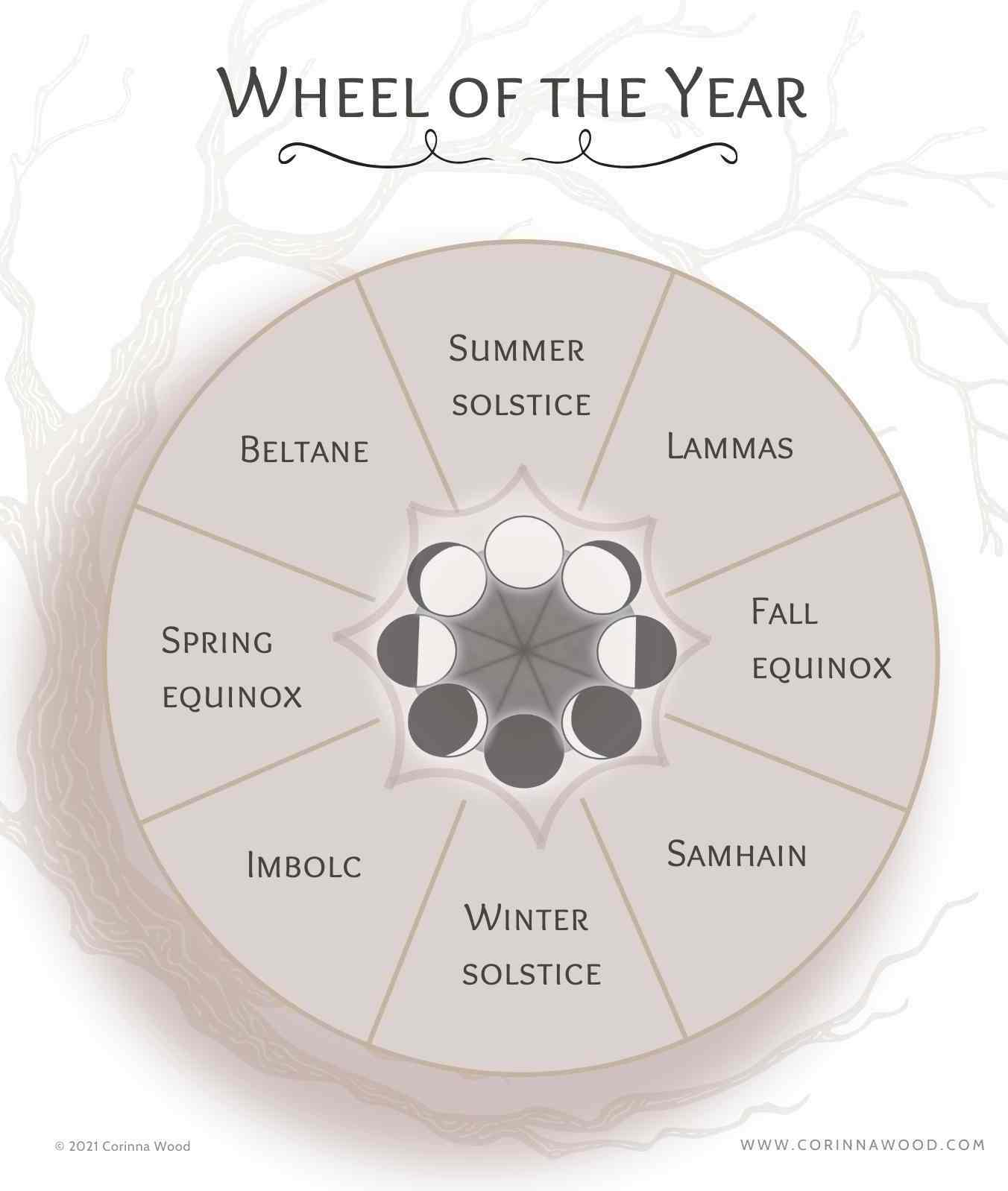
You're welcome to grab a free copy of my quick reference guide: Tuning into the Wheel of the Year
Over these darker months of the year, we're naturally pulled to shift our focus inward, toward self-reflection and restoration.
My invitation to you is to rest with the cycles of nature, sending your energy down to your "roots" that you may re-enter the next year from a nourished and replenished place.
Creating your Samhain ritual
As you think about your Samhain ritual, know that I’m offering a multitude of ideas that can guide you. So you don’t get overwhelmed, I suggest you hone in on one or two that resonate for you at this time. You can always go back and do others later.
See what you're drawn to, and follow your intuition.
1) Samhain rituals to honor your beloved dead

Because the veils between the worlds are often considered to be thinnest at Samhain, this is a powerful opportunity to connect with and honor your ancestors or beloved dead.
Carve out space and time to allow memories and stories to surface and find ways to ground them through writing, art, or sharing with others. This includes not just people, but can also include pet companions or any being that is in your circle of beloveds.
Honor your memories of your beloved dead
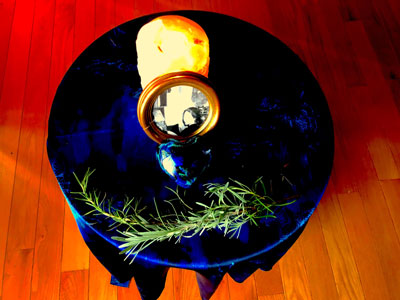 There are so many ways to honor and celebrate the memories of your beloved dead.
There are so many ways to honor and celebrate the memories of your beloved dead.
I like to create an altar on a small table, shelf or mantle with a photo of my beloved, a candle and a sprig of rosemary for remembrance.
This space provides a focal point for remembering and honoring those who have died—you may consider this a Samhain blessing for your beloveds.
Feel free to get creative to honor their memories.
For example, you might . . .
- Create a photo collage
- Gather special objects or symbols that represent their energy in your life
- Write or read a poem that captures their essence or the specialness of your relationship
- Create a memory quilt, with each square honoring a different aspect of their life, or gather a group of friends and loved ones to each design a quilt square in memory of your beloved
- Write memories of your beloved dead on small pieces of paper and gather them in a bowl. Pull one strip of paper at a time to read aloud. Write, draw or tell stories associated with the memory.
Leave your altar up for at least a few days—or as long as you like into the winter.
Take a moment each day to pause, reflect and connect with the memory of your beloved dead and ancestors. You might light a candle or burn a bit of an herbal bundle for scent.
Create your own ancestor feast
 I've appreciated participating in community "ancestor feasts" some years at Samhain. Folks shared stories about their beloveds—and the next day we took a walk to visit the graves of community members who have died.
I've appreciated participating in community "ancestor feasts" some years at Samhain. Folks shared stories about their beloveds—and the next day we took a walk to visit the graves of community members who have died.
Creating a special meal is a simple and powerful way of honoring your ancestors or those who have died.
Our sense of smell and taste have strong links to our memories. Eating and smelling food that reminds us of our honored dead can evoke strong memories and feelings.
Over the meal you could reflect on memories and stories, by yourself or with others, of those who have passed. I’ve even known friends who find themselves craving a food during Samhain they don’t normally eat, but was a favorite of a beloved who died!
To create your own ancestor feast at home for yourself or your family, you might:
- Make a plate of food for your beloved, perhaps set a place at the table, or leave an empty chair with a plate of food.
- Prepare the favorite foods of your beloved dead.
- Share stories of your beloved or ancestors with one another.
- Share stories of your own life with your beloved dead or ancestors
After the meal you may wish to leave a plate outside where the animals and birds can enjoy it as a way of honoring the cycles of life.
2) Samhain grief rituals

You may want to include a space for grieving in your rituals for Samhain—whether mourning beloved dead, or your own pain, grief, or losses.
I was blessed to study with Sobanfu Somé, now an ancestor herself.
Sobanfu encouraged us to embrace our grief, to feel the depth of our sorrows and to release the emotions that come with it.
When we hold our feelings in, we can begin to feel numb, disconnected and stuck.
Sobanfu often reminded us that there is no time limit on grief: it takes as long as it takes.
I love the power of communal grieving—however simply going out into a safe place in nature and crying with your plant allies can be deeply healing.
Taking time to recognize your losses
 Grief and mourning are a natural response to change and loss.
Grief and mourning are a natural response to change and loss.
In Chinese medicine, the fall is considered the time of the lungs—and grief is the emotion connected to the lungs.
So in holistic healing for earth-based women, we nourish the lungs at this time of year. Yes, physically with herbs. And also emotionally, by giving yourself room to feel your grief.
When creating a grief ritual, you may choose to honor losses from the past year or maybe losses throughout your lifetime.
I like to begin by creating a litany of losses.
Depending on your level of comfort and safety, you may speak these aloud to yourself or with others.
On your list of losses you may include things such as:
- Death of a beloved
- Loss of dreams and hopes
- Loss of a relationship
- Loss of health
- Loss of a job or home
- Loss of unmet needs in your life
- Loss of a previous version of yourself
Rituals to release emotions of grief
 Samhain provides an opportunity to vocalize and release those emotions that you may have pushed down or stifled over time.
Samhain provides an opportunity to vocalize and release those emotions that you may have pushed down or stifled over time.
As you create sound or allow the tears to flow, it allows the energy to become unstuck and move through your body.
You can do this alone, or with others you trust.
Some suggestions for creating your own grief ritual:
- Create or go to a safe place
- Create a focal point for your grief—this may be an altar, a cauldron, a candle or firebowl, or other symbol of transformation
- Play music that can evoke your emotions or allow you to let down your internal barriers
- Allow yourself to cry, wail, keen, yell or otherwise express your emotions
- If you're in a group, take turns visiting the focal point to express your grief. Support one another without interrupting the flow of emotion—place a hand on the back, or sit or stand close by so the grieving person knows they are not alone.
3) Samhain rituals for letting go

Another way to honor the season is to create a simple ritual of letting go—to release things that have been weighing you down or holding you back.
This is a powerful way to prepare for the time of darkness and self reflection of the winter months.
This may include doing a gesture—such as letting a leaf fall into the water as you speak your intentions aloud. You're releasing something you're ready to let go, such as:
- Your efforts this year—whether they resulted in harvests or losses
- A time of your life or aspect of your life
- Addictions or behavior patterns that no longer serve you
- Old beliefs that may hold you back
Working with fire
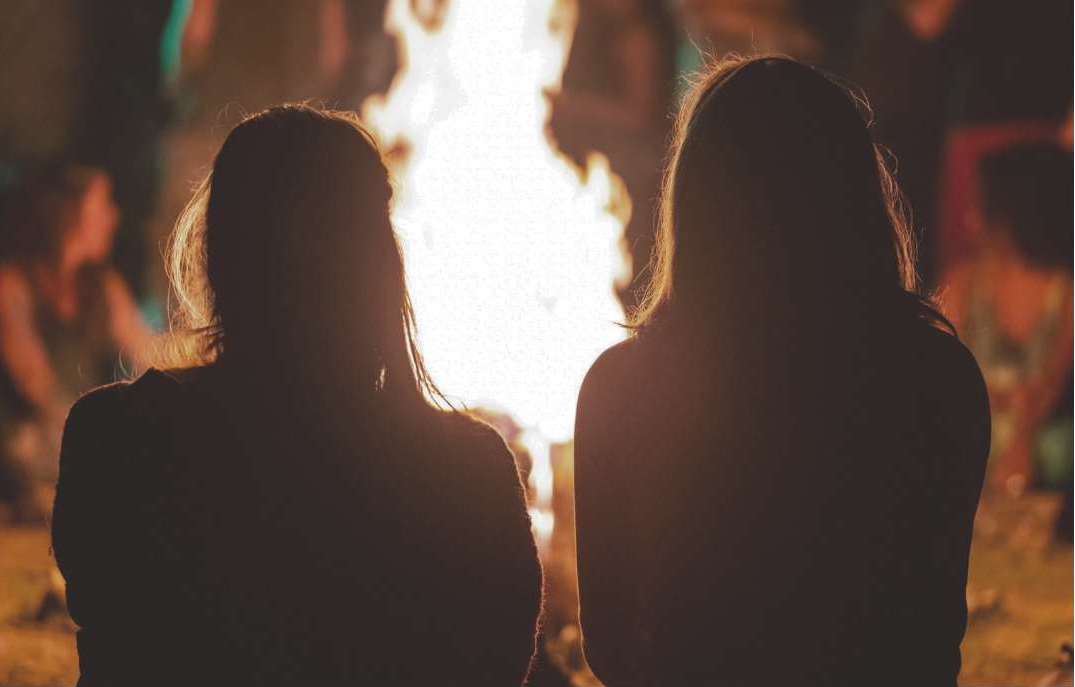 Fire is a potent way to release, let go or transform. Giving your burdens to the fire is a way of burning off the dross from the year—those things that “stick” to you that are not part of your essence.
Fire is a potent way to release, let go or transform. Giving your burdens to the fire is a way of burning off the dross from the year—those things that “stick” to you that are not part of your essence.
And then after doing that you can enjoy the warmth and magic of the flames!
As a mother, I found that building a small outdoor fire was an easy and fun way to mark this holy day for my family—to honor that this holy day is more than trick-or-treating. Kids and adults alike love to learn fire building and it provides a natural central focus for honoring this marker in the turning of the seasons.
If you prefer you could build a fire in a fireplace or wood stove, or just use a candle. Here are some gestures that could be part of your Samhain letting go ritual around the fire
- Write what you wish to let go of on a small piece of paper or burnable objects like sticks, pine cones, small blocks of wood, etc and feed them to the fire as a way to release or transform.
- Speak what you are letting go as you release it to the fire. Let your emotions arise, giving energy to the release.
- If your intention is to transform as well as release, you might also speak to what transformation you are seeking.
- Enjoy the warmth of the fire, the magic of the dancing flames
- Maybe warm up nourishing food or drink to honor the work you have done.
Other rituals for letting go
 If you’re not drawn to fire this time, consider other gestures for letting go of the year, of all that you accomplished and all the effort it took.
If you’re not drawn to fire this time, consider other gestures for letting go of the year, of all that you accomplished and all the effort it took.
Remember, letting go and loss are inherent to the natural cycles, like the leaves falling from the trees and plants dying in this season of the year.
By releasing those things that no longer serve, you have fewer encumbrances as you head into a time for deeper inner work.
See which ideas resonate for you:
- Find a natural object to represent your year. Let it go in a stream or moving water, and let the water carry it all away
- Spend time in your garden, putting your harvests to bed, honoring the end of the growing season.
- Sort through your belongings or clean the closets of clothes and things that you no longer need. Donate them to a thrift store as a way of lightening your load physically
An example of a simple Samhain ritual
Consider what resonates for you right now. Here's an example from my life currently...
As I walk the forest paths this Samhain season, the fallen acorns remind me of my beloved sister friend Rowan Farrell, whose photo is on my beloved dead altar this year.
Long ago Rowan learned to make acorn bread. She would gather up a bucket of acorns, crack their shells, leach out the tannins and then grind the nuts into flour. She offered me a piece, wide and flat like zucchini bread. I still remember the moist texture and nutty flavor.
Recent years have brought loss for many of us. When another beloved–a precious mentor of mine–died last year, a sister proclaimed “a tall oak tree has fallen."
I often associate oak trees with the women who came before us, those upon whose shoulders we stand.
Even though they've left the earth plane, they gave us all that we need in the seed of an acorn, that we may plant it, tend it, and grow into the fullness of our own being.
As I gather a handful of acorns to add to my beloved dead altar, I feel a sense of promise.
I dream of the future, imagining the women who will someday stand on our shoulders.
The acorn holds both the memory of those who have passed and the promise of those yet to come–much like the cycle of life and the seasons that are integral to the spiral we walk in the Wise Woman Tradition.
Samhain blessings to you
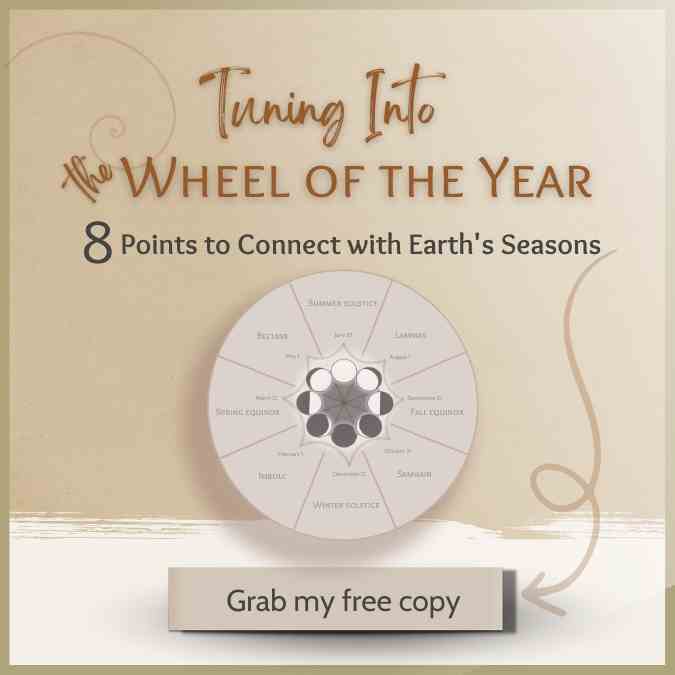 The potent energies of Samhain offer a unique opportunity to connect deeply with our roots, our past, and ourselves.
The potent energies of Samhain offer a unique opportunity to connect deeply with our roots, our past, and ourselves.
The rituals and blessings detailed in this article—honoring the beloved dead, grieving, and letting go—are avenues to harness this special time. Yet, diving into all of them at once would be overwhelming.
So, where shall you begin?
Consider this your gentle reminder: start with one. Tune into what calls you right now. Is there a particular ritual or gesture that tugs at your heart or stirs a emotion within you? That's your starting point.
Perhaps it's setting up a small altar for a departed loved one or simply letting a leaf fall into the water as a symbolic gesture of letting go.
At the heart of Samhain is honoring cycles—cycles of life, death, and rebirth. As you delve into your chosen ritual, allow yourself to truly feel and connect with the season, honoring where you are in your own personal cycle.
Remember, simplicity can hold immense power. One ritual, one intention, and one moment of genuine connection can offer profound healing and clarity.
Embrace the magic of Samhain, and let it guide you. Whatever ritual you choose, know that you're honoring both the past and the possibilities of what's to come. And over time, there are more rituals to explore and weave into the fabric of your life.
Samhain blessings to you, sweet sister! 🍂🌙
______________
Spread the wise woman ways! Link to this article from your website or share with your friends using this button~
Comments ~ what ritual are you most drawn to right now?

